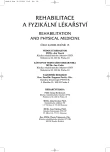Position-Related Vertigo Should not be Forgotten in Clinical Practice
Authors:
O. Čakrt 1; P. Kolář 1; J. Jeřábek 2
Authors‘ workplace:
Klinika rehabilitace 2. LF UK a FN Motol, Praha
přednosta doc. PeadDr. P. Kolář
1; Neurologická klinika dospělých 2. LF UK a FN Motol, Praha
přednosta doc. MUDr. M. Bojar, CSc.
2
Published in:
Rehabil. fyz. Lék., 15, 2008, No. 4, pp. 163-166.
Category:
Original Papers
Overview
In clinical practice we often encounter position-related vertigo. Correct differential diagnosis is of principal significance for selection of therapeutic procedure. The available literature (2, 4, 9) indicates that most frequently occurring position-related vertigo is the benign paroxysmal positional vertigo (BPPV). The disease can be diagnosed in most cases by means of specific position tests and subsequently successfully treated. However, principal differences of the clinical picture of BPPV from other kinds of vertigo must be established in order to avoid diagnostic and therapeutic errors.
Key words:
position-related vertigo, benign paroxysmal positional vertigo, reposition maneuvers, vestibular rehabilitation
Sources
1. Baloh, R. W., Jacobson, K., Honrubia, V.: Horizontal senicirkular canal variant of benign positional vertigo. Neurology, 43, 1993, 12.
2. Brandt, T., Dieterich, M., Strupp, M. eds.: Vertigo and dizziness common complaints. London, Springer, 2005.
3. BRANDT, T., STEDDIN, S.: Current view of the mechanism of benign paroxysmal positional vertigo: cupulolithiasis or canalolithiasis? J. Vestib. Res., 3, 1993, 4, s. 373-382.
4. Buttner, U., Helmchen, C., Brandt, T.: Diagnostic criteria for central versus peripheral positioning nystagmus and vertigo: a review. Acta Otolaryngol., 119, 1999, 1, s. 1-5.
5. Cohen, H. S., Jerabek, J.: Efficacy of treatments for posterior canal benign paroxysmal positional vertigo. Laryngoskope, 109, 1999, 4, s. 584-590.
6. Epley, J. M.: Human experience with canalith repositioning maneuvers. Ann N Y Acad. Sci., 2001, s. 179-191.
7. Herdman, S. J.: Vestibular rehabilitation. In Baloh R. W., Halmagyi G. M. (eds.): Disorders of the vestibular system. Oxford University Press, 1996, s. 583-597.
8. KAtsarkas, A.: Benign paroxysmal positional vertigo (BPPV): idiopathic versus post-traumatic. Acta Otolagyngol., 119, 1999, 7, s. 745-749.
9. Parnes, L. S., Agrawal, S. K., Atlas, J.: Diagnosis and management of benign paroxysmal positional vertigo (BPPV). CMAJ, 169, 2003, 7, s. 681-693.
10. PARNES, L. S., AGRAWAL, S. K., ATLAS, J.: Diagnosis and management of benign paroxysmal positional vertigo (BPPV). CMAJ, 169, 2003, 7, s. 681-693.
11. RADTKE, A., VON BREVERN, M., TIEL-WILCK, K., MAINZ-PERCHALLA, A., NEUHAUSER, H., LEMPERT, T.: Neurology. 63, 2004, 1, s. 8-9.
Labels
Physiotherapist, university degree Rehabilitation Sports medicineArticle was published in
Rehabilitation & Physical Medicine

2008 Issue 4
- Hope Awakens with Early Diagnosis of Parkinson's Disease Based on Skin Odor
- Deep stimulation of the globus pallidus improved clinical symptoms in a patient with refractory parkinsonism and genetic mutation
Most read in this issue
- Position-Related Vertigo Should not be Forgotten in Clinical Practice
- Survey of Present Opinions on the Problems of Hamstring Injuries in Sportsmen and Sportswomen
- Survey of Rehabilitation Methods in the Treatment of Urinary Incontinence Results of Foreign and Domestic Studies in Rehabilitation Therapy of Urinary Incontinence
- Effect of Musculus Levator Scapulae on Lordosis of Cervical Spine
